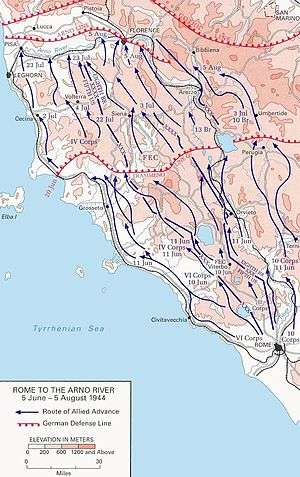Trasimene Line

The Trasimene Line (so-named for Lake Trasimene, the site of a major battle of the Second Punic War in 217 BCE) was a German defensive line during the Italian Campaign of World War II. It was sometimes known as the Albert Line. The commander of the German forces in Italy, Field Marshal Albert Kesselring used the line to delay the Allied northward advance in Italy in mid June 1944 to buy time to withdraw troops to the Gothic Line and finalise the preparation of its defenses.
Background
After the Allied capture of Rome on 4 June 1944 following the successful breakthrough at Monte Cassino and Anzio during Operation Diadem in May 1944, the German Fourteenth and Tenth Armies fell back: the Fourteenth along the Tyrrhenian front and Tenth through central Italy and the Adriatic coast. There was a huge gap between the armies and with the Allies advancing some 10 km per day, the flanks of both armies were exposed and encirclement was threatened.[1]
Two days after Rome fell, General Sir Harold Alexander, commander of the Allied Armies in Italy, received orders from General Sir Henry Maitland Wilson, the supreme Allied commander Allied forces Mediterranean theatre to push the Germans 170 miles north to a line running from Pisa to Rimini (i.e. the Gothic Line) as quickly as possible to prevent the establishment of any sort of coherent enemy defense in central Italy.
'War in Val D'Orcia' is a civilian's diary of the war in this area, describing the experiences of the author and her family, caught between local Fascists and Partisans, retreating Germans and advancing Allies.
Battle
On Mark Clark's U.S. Fifth Army front U.S. VI Corps was pushed up the coast along highway 1 and U.S. II Corps along highway 2 towards Viterbo. To their right British Eighth Army's British XIII Corps headed up highway 3 towards Terni and Perugia[2] whilst V Corps advanced up the Adriatic coast.
Between 4 June and 16 June, whilst maintaining contact with the advancing Allies, Albert Kesselring executed a remarkable and unorthodox maneuver with his depleted divisions, resulting in his two armies aligning and uniting their wings on the defensive positions on the Trasimene Line.[1] Remarkable though this was, he was probably helped by the confusion caused in the Allied advance by the relieving of II and VI Corps (substituted by U.S. IV Corps and the French Expeditionary Corps). British X Corps had also been brought into the line on XIII Corps' right whilst V Corps had been relieved by Polish II Corps.
By the last week of June the Allies were facing the Trasimene positions. Joachim Lemelsen's Fourteenth Army had Frido von Senger und Etterlin's XIV Panzer Corps facing IV Corps on the west coast and Alfred von Schlemm's 1st Parachute Corps facing the French Expeditionary Corps beside them.
Heinrich von Vietinghoff's Tenth Army had Traugott Herr's LXXVI Panzer Corps facing XIII and X Corps and Valentin Feurstein's LI Mountain Corps facing the Polish Corps on the Adriatic. The toughest defenses were around the lake itself with XIII Corps' 78th Infantry Division experiencing fierce fighting on 17 June at Città della Pieve and 21 June at San Fatucchio. By 24 June they had worked their way round to the north shore and linked with X Corps' 4th Indian and 10th Indian Infantry Divisions as the German defenders withdrew towards Arezzo.[3]
IV Corps also found progress slow but by 1 July had crossed the river Cecina and were within 20 miles of Livorno. Meanwhile, the French Corps had been held up on the river Orcia west of Lake Trasimene until the parachutist defenders withdrew on 27 June allowing them to enter Siena on 3 July.[4]
Footnotes
References
- Carver, Field Marshal Lord (2001). The Imperial War Museum Book of the War in Italy 1943-1945. London: Sidgwick & Jackson. ISBN 0 330 48230 0.
- Laurie, Clayton D. (Revision of 3 October 2003) [1994]. Rome-Arno 1944. U.S. Army Campaigns of WWII. Washington: United States Army Center of Military History. ISBN 978-0-16-042085-6. CMH Pub 72-20. Check date values in:
|date=(help) - Muhm, Gerhard. "German Tactics in the Italian Campaign".